Composite Demand-Based Energy Storage Sizing for an Isolated Microgrid System
Abstract
:1. Introduction
2. Research Methodology and Modeling
2.1. Problem Statement
- Some number (G) of CG units with known specifications.
- Energy and power capital cost of the ESS, and charging and discharging efficiencies.
- Historical solar radiation data (Gh) divided into four groups: summer (GSu), fall (GFa), winter (GWi), and spring (GSp).
- Historical demand data (Dh) for the specific region and season.
- A solar farm (SF) consists of NSCG SCGs, for which the specifications and FORs are given.
2.2. Computation of the Expected Output Power of the SF and Composite Demand
2.2.1. Computation of the Expected Output Power of the SF
2.2.2. Composite Demand PDF Computation
2.3. Formulation of the Optimized Sizing of the Energy Storage
3. Results
3.1. Power Outputs of the Expected SF and Composite Demand PDF Results
3.2. ESS Sizing and CG Operational Cost Results
4. Conclusions
Author Contributions
Funding
Institutional Review Board Statement
Informed Consent Statement
Data Availability Statement
Conflicts of Interest
References
- IEEE Std 2030.7-2017; IEEE Standard for the Specification of Microgrid Controllers. IEEE: New York, NY, USA, 2018; pp. 1–43.
- Choudhury, S. A comprehensive review on issues, investigations, control and protection trends, technical challenges and future directions for Microgrid technology. Int. Trans. Electr. Energy Syst. 2020, 30, e12446. [Google Scholar] [CrossRef]
- The, U.S. Energy Information Administration (EIA). U.S. Battery Storage Market Trends; The U.S. Energy Information Administration (EIA): Washington, DC, USA, 2018. [Google Scholar]
- Parhizi, S.; Lotfi, H.; Khodaei, A.; Bahramirad, S. State of the Art in Research on Microgrids: A Review. IEEE Access 2015, 3, 890–925. [Google Scholar] [CrossRef]
- Ghiassi-Farrokhfal, Y.; Rosenberg, C.; Keshav, S.; Adjaho, M.-B. Joint Optimal Design and Operation of Hybrid Energy Storage Systems. IEEE J. Sel. Areas Commun. 2016, 34, 639–650. [Google Scholar] [CrossRef] [Green Version]
- Dong, J.; Gao, F.; Guan, X.; Zhai, Q.; Wu, J. Storage Sizing with Peak-Shaving Policy for Wind Farm Based on Cyclic Markov Chain Model. IEEE Trans. Sustain. Energy 2016, 8, 978–989. [Google Scholar] [CrossRef]
- Arabali, A.; Ghofrani, M.; Etezadi-Amoli, M.; Fadali, M.S. Stochastic Performance Assessment and Sizing for a Hybrid Power System of Solar/Wind/Energy Storage. IEEE Trans. Sustain. Energy 2013, 5, 363–371. [Google Scholar] [CrossRef]
- Alamri, A.; AlOwaifeer, M.; Meliopoulos, A.S.; Cokkinides, G.J. Energy Storage Sizing and Reliability Assessment for Power Systems with Variable Generation. In Proceedings of the 2019 IEEE Milan PowerTech, Milano, Italy, 23–27 June 2019; pp. 1–6. [Google Scholar] [CrossRef]
- Alamri, A.; Alowaifeer, M.; Meliopoulos, A.P.S. Energy Storage Sizing and Probabilistic Reliability Assessment for Power Systems Based on Composite Demand. IEEE Trans. Power Syst. 2021, 37, 106–117. [Google Scholar] [CrossRef]
- Zhang, Y.; Wang, J.; Berizzi, A.; Cao, X. Life cycle planning of battery energy storage system in off-grid wind_solar_diesel microgrid. IET Gener. Transmiss. Distrib. 2018, 12, 4451–4461. [Google Scholar] [CrossRef]
- Zolfaghari, M.; Ghaffarzadeh, N.; Ardakani, A.J. Optimal sizing of battery energy storage systems in off-grid micro grids using convex optimization. J. Energy Storage 2019, 23, 44–56. [Google Scholar] [CrossRef]
- Hesaroor, K.; Das, D. Optimal sizing of energy storage system in islanded microgrid using incremental cost approach. J. Energy Storage 2019, 24, 100768. [Google Scholar] [CrossRef]
- Pham, C.M.; Tran, Q.T.; Bacha, S.; Hably, A.; Nugoc, A.L. Optimal sizing of battery energy storage system for an island microgrid. In Proceedings of the IECON 2018—44th Annual Conference of the IEEE Industrial Electronics Society, Washington, DC, USA, 21–23 October 2018. [Google Scholar]
- Bahramirad, S.; Reder, W.; Khodaei, A. Reliability-Constrained Optimal Sizing of Energy Storage System in a Microgrid. IEEE Trans. Smart Grid 2012, 3, 2056–2062. [Google Scholar] [CrossRef]
- Zhu, W.; Guo, J.; Zhao, G.; Zeng, B. Optimal Sizing of an Island Hybrid Microgrid Based on Improved Multi-Objective Grey Wolf Optimizer. Processes 2020, 8, 1581. [Google Scholar] [CrossRef]
- Cao, B.; Dong, W.; Lv, Z.; Gu, Y.; Singh, S.; Kumar, P. Hybrid Microgrid Many-Objective Sizing Optimization With Fuzzy Decision. IEEE Trans. Fuzzy Syst. 2020, 28, 2702–2710. [Google Scholar] [CrossRef]
- Bandyopadhyay, S.; Mouli, G.R.C.; Qin, Z.; Elizondo, L.R.; Bauer, P. Techno-Economical Model Based Optimal Sizing of PV-Battery Systems for Microgrids. IEEE Trans. Sustain. Energy 2019, 11, 1657–1668. [Google Scholar] [CrossRef]
- Ropero-Castaño, W.; Muñoz-Galeano, N.; Caicedo-Bravo, E.F.; Maya-Duque, P.; López-Lezama, J.M. Sizing Assessment of Islanded Microgrids Considering Total Investment Cost and Tax Benefits in Colombia. Energies 2022, 15, 5161. [Google Scholar] [CrossRef]
- Park, J.; Liang, W.; Choi, J.; El-Keib, A.A.; Shahidehpour, M.; Billinton, R. A probabilistic reliability evaluation of a power system including Solar/Photovoltaic cell generator. In Proceedings of the 2009 IEEE Power & Energy Society General Meeting, Calgary, AB, Canada, 26–30 July 2009; pp. 1–6. [Google Scholar] [CrossRef]
- Allan, R.; Billinton, R. Reliability Evaluation of Power Systems, 1st ed.; Plenum: New York, NY, USA, 1996. [Google Scholar]
- Ostrowski, J.; Anjos, M.F.; Vannelli, A. Tight Mixed Integer Linear Programming Formulations for the Unit Commitment Problem. IEEE Trans. Power Syst. 2011, 27, 39–46. [Google Scholar] [CrossRef]
- Atakan, S.; Lulli, G.; Sen, S. A State Transition MIP Formulation for the Unit Commitment Problem. IEEE Trans. Power Syst. 2017, 33, 736–748. [Google Scholar] [CrossRef] [Green Version]
- Baker, K.; Hug, G.; Li, X. Energy Storage Sizing Taking into Account Forecast Uncertainties and Receding Horizon Operation. IEEE Trans. Sustain. Energy 2016, 8, 331–340. [Google Scholar] [CrossRef]
- Zimmerman, R.D.; Murillo-Sanchez, C.; Thomas, R.J. MATPOWER’s extensible optimal power flow architecture. In Proceedings of the 2009 IEEE Power & Energy Society General Meeting, Calgary, AB, Canada, 26–30 July 2009; pp. 1–7. [Google Scholar]
- Wood, A.J.; Wollenberg, B.F. Power Generation, Operation, and Control, 2nd ed.; Wiley: New York, NY, USA, 1996. [Google Scholar]
- Carrion, M.; Arroyo, J. A Computationally Efficient Mixed-Integer Linear Formulation for the Thermal Unit Commitment Problem. IEEE Trans. Power Syst. 2006, 21, 1371–1378. [Google Scholar] [CrossRef]
- Renewable Resource Atlas, King Abdullah City for Atomic and Renewable Energy (K.A.CARE). Available online: https://www.energy.gov.sa/en/projects/Pages/atlas.aspx (accessed on 23 August 2022).
- Open Energy Data Initiative (OEDI). The U.S. Department of Energy (DOE). Available online: https://data.openei.org (accessed on 20 September 2022).
- Bahramirad, S.; Camm, E. Practical modeling of Smart Grid SMS storage management system in a microgrid. In Proceedings of the PES T&D 2012, Orlando, FL, USA, 7–10 May 2012; pp. 1–7. [Google Scholar] [CrossRef]
- NREL System Advisor Model (SAM). Available online: https://sam.nrel.gov (accessed on 12 June 2022).
- Spertino, F.; Chiodo, E.; Ciocia, A.; Malgaroli, G.; Ratclif, A. Maintenance Activity, Reliability, Availability, and Related Energy Losses in Ten Operating Photovoltaic Systems up to 1.8 MW. IEEE Trans. Ind. Appl. 2020, 57, 83–93. [Google Scholar] [CrossRef]
- Schoenung, S. Energy Storage Systems Cost Update: A Study for the DOE Energy Storage Systems Program; Department of Energy: USA, 2011. [Google Scholar] [CrossRef]
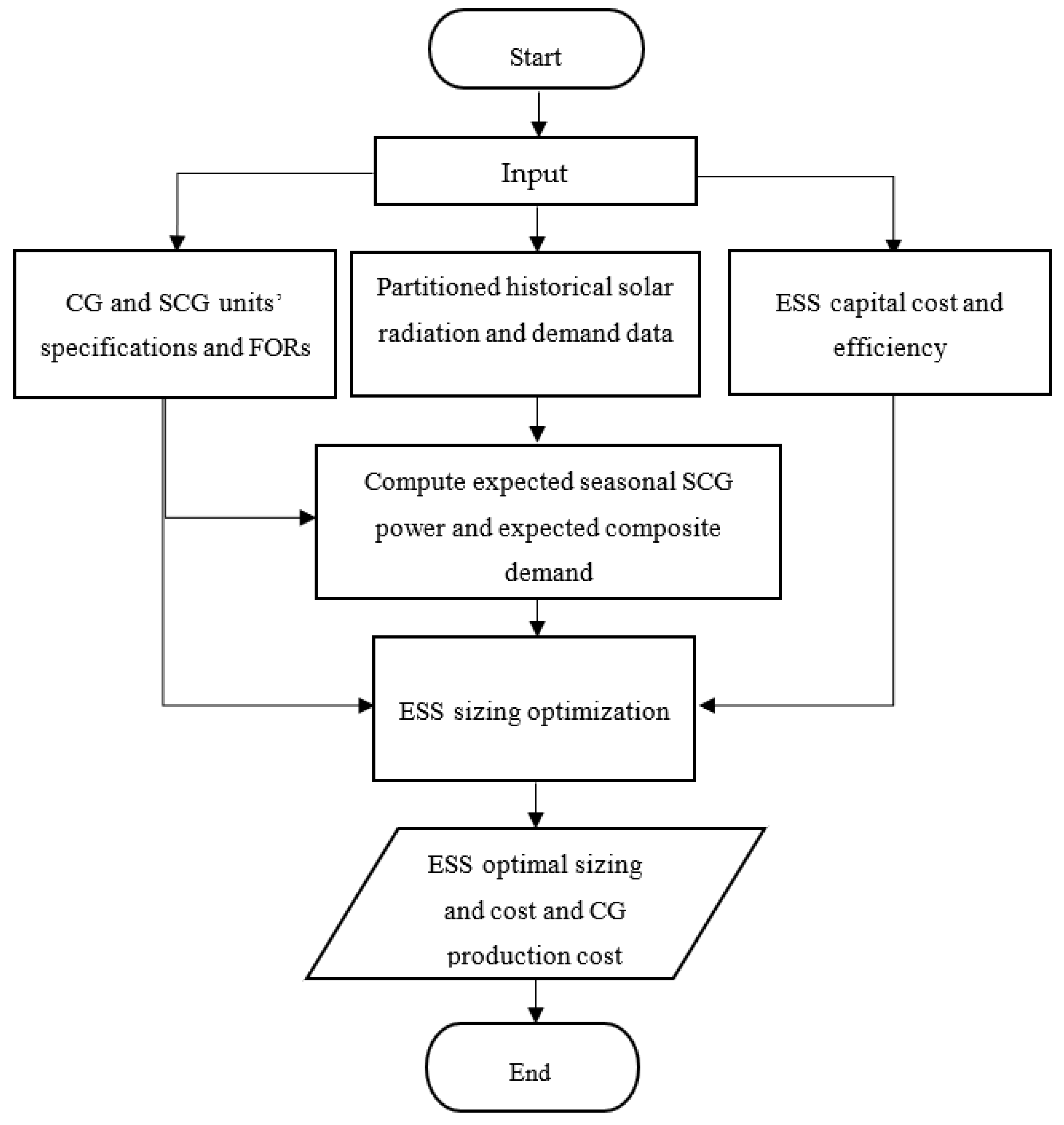
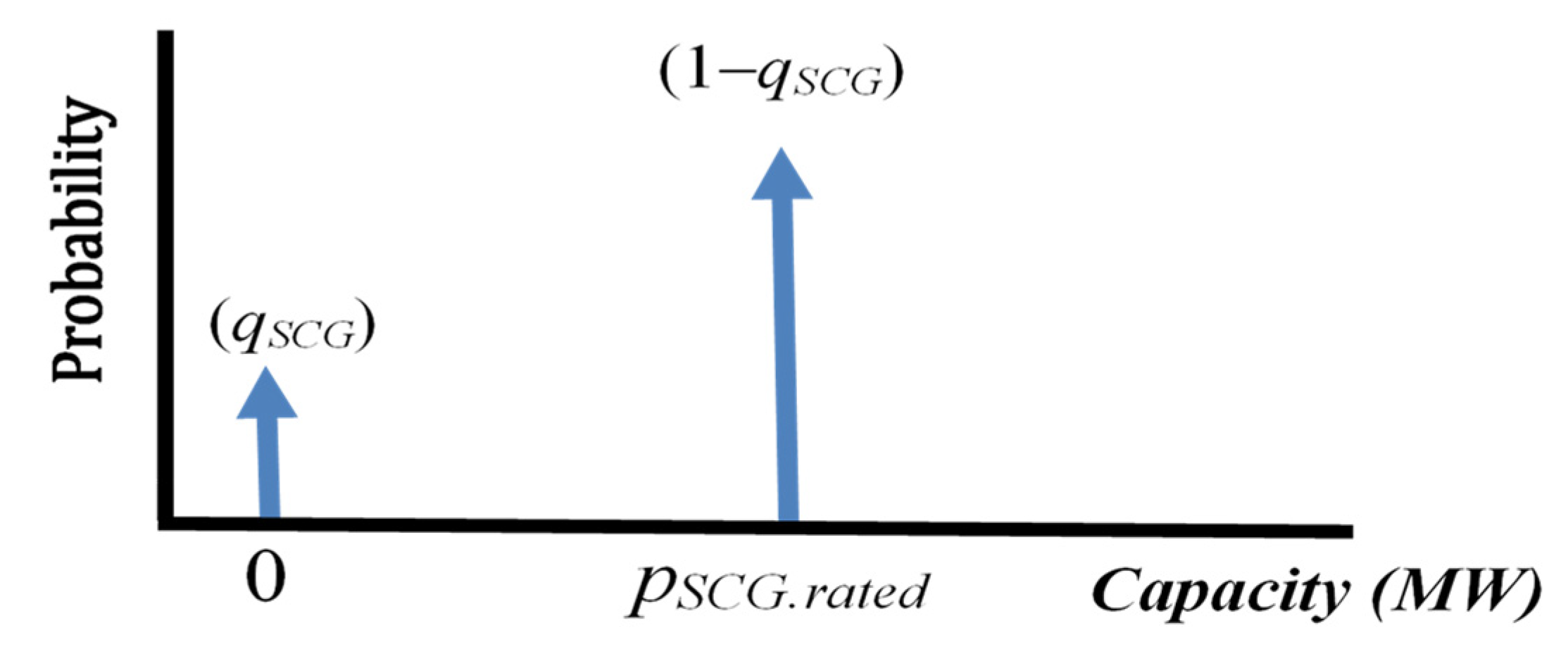

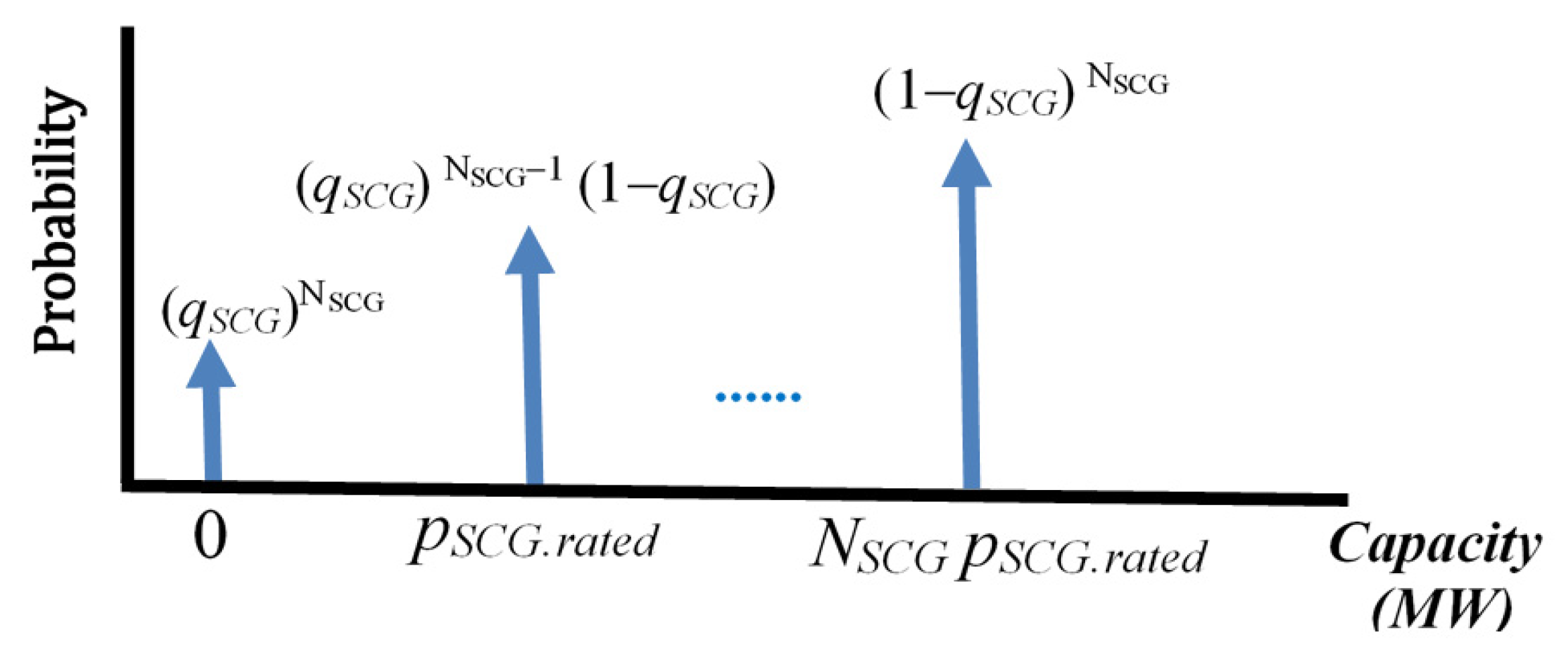
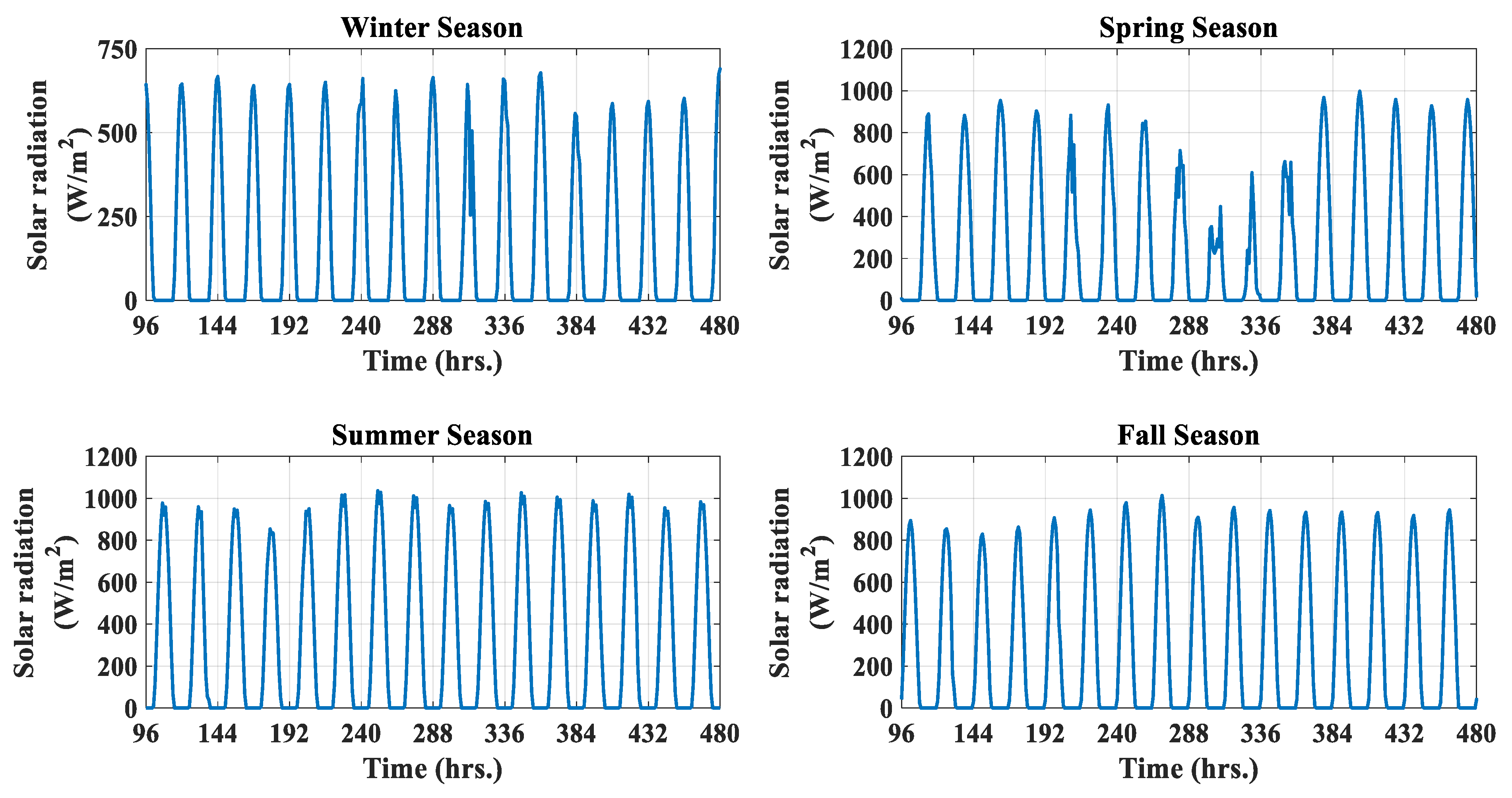
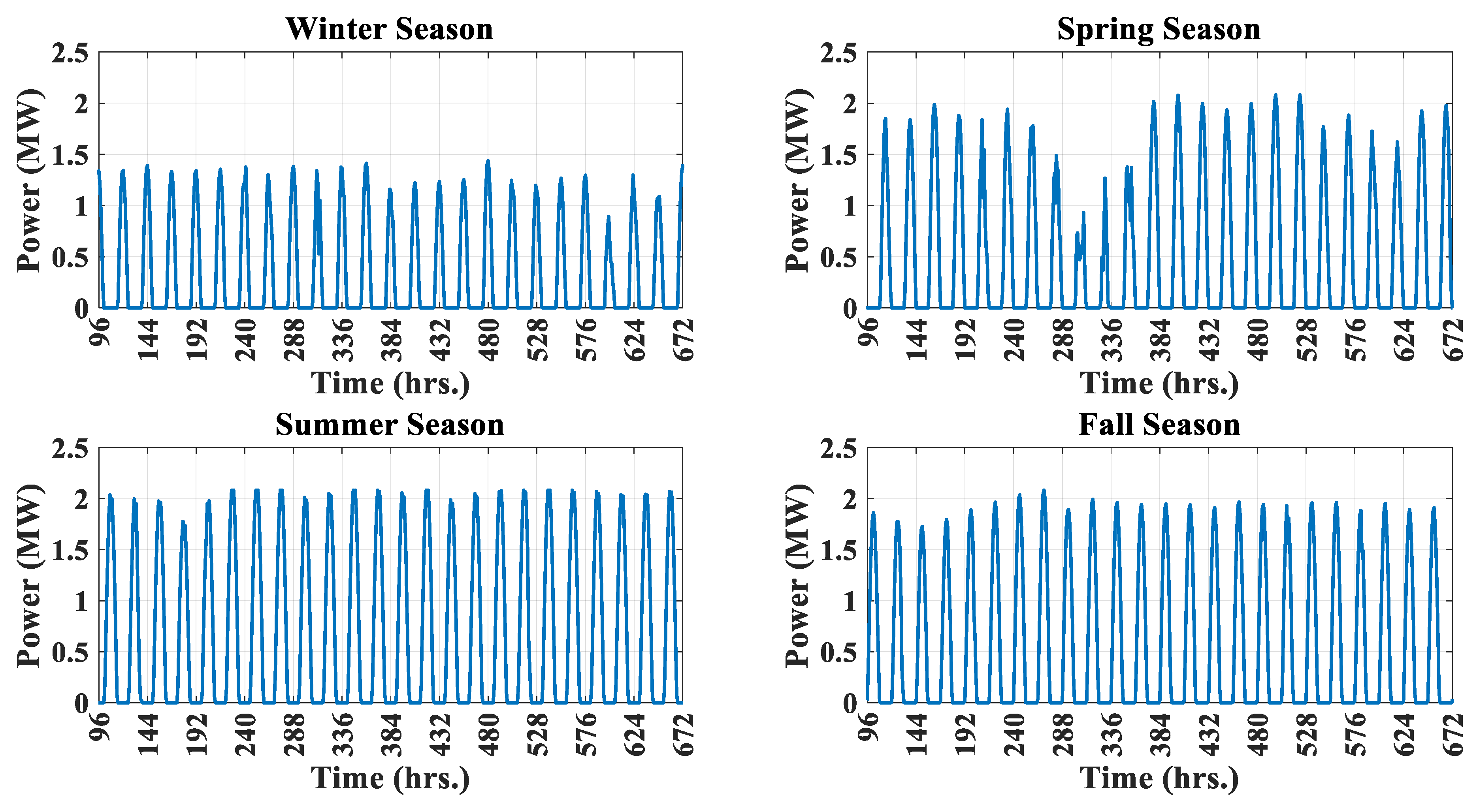

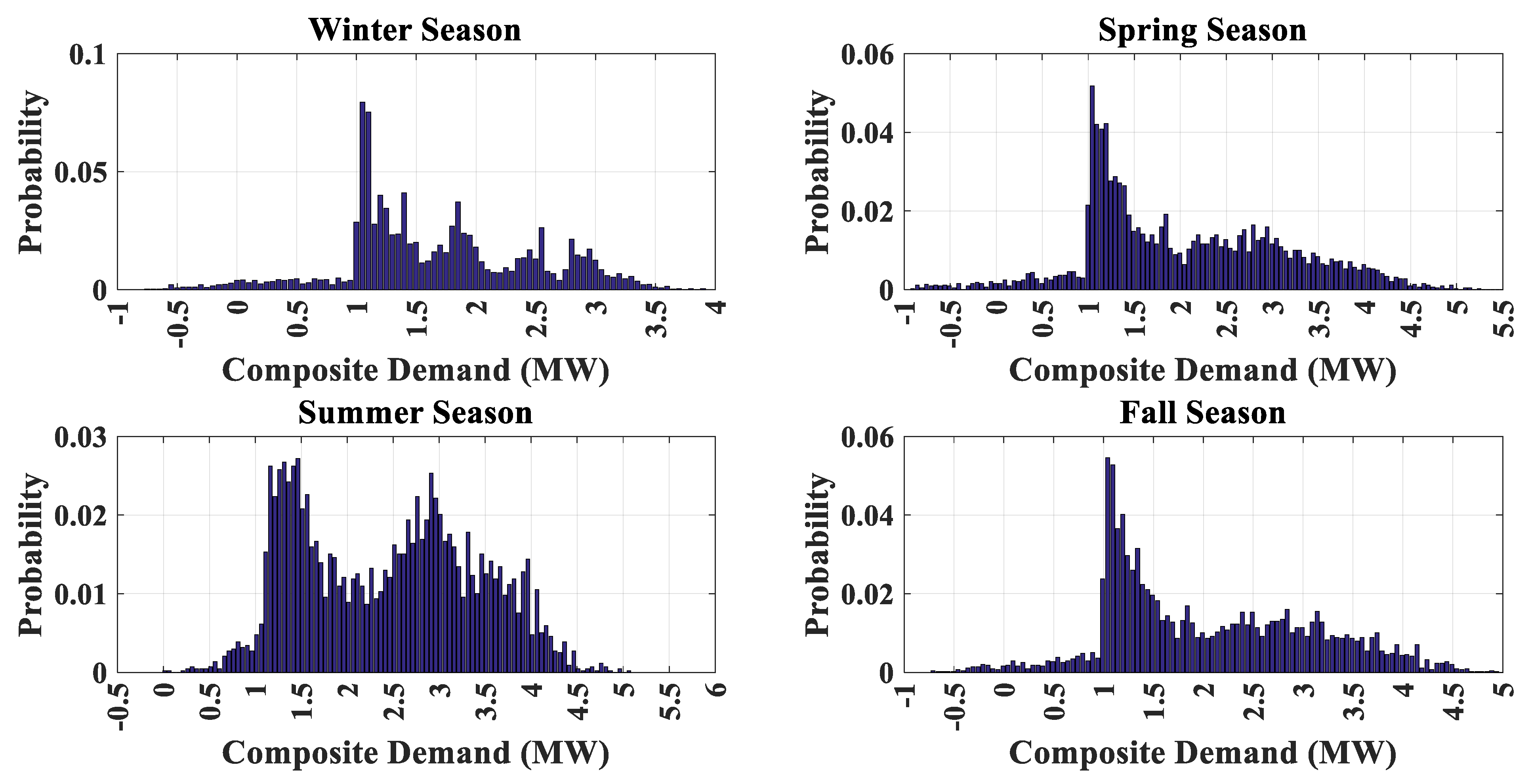
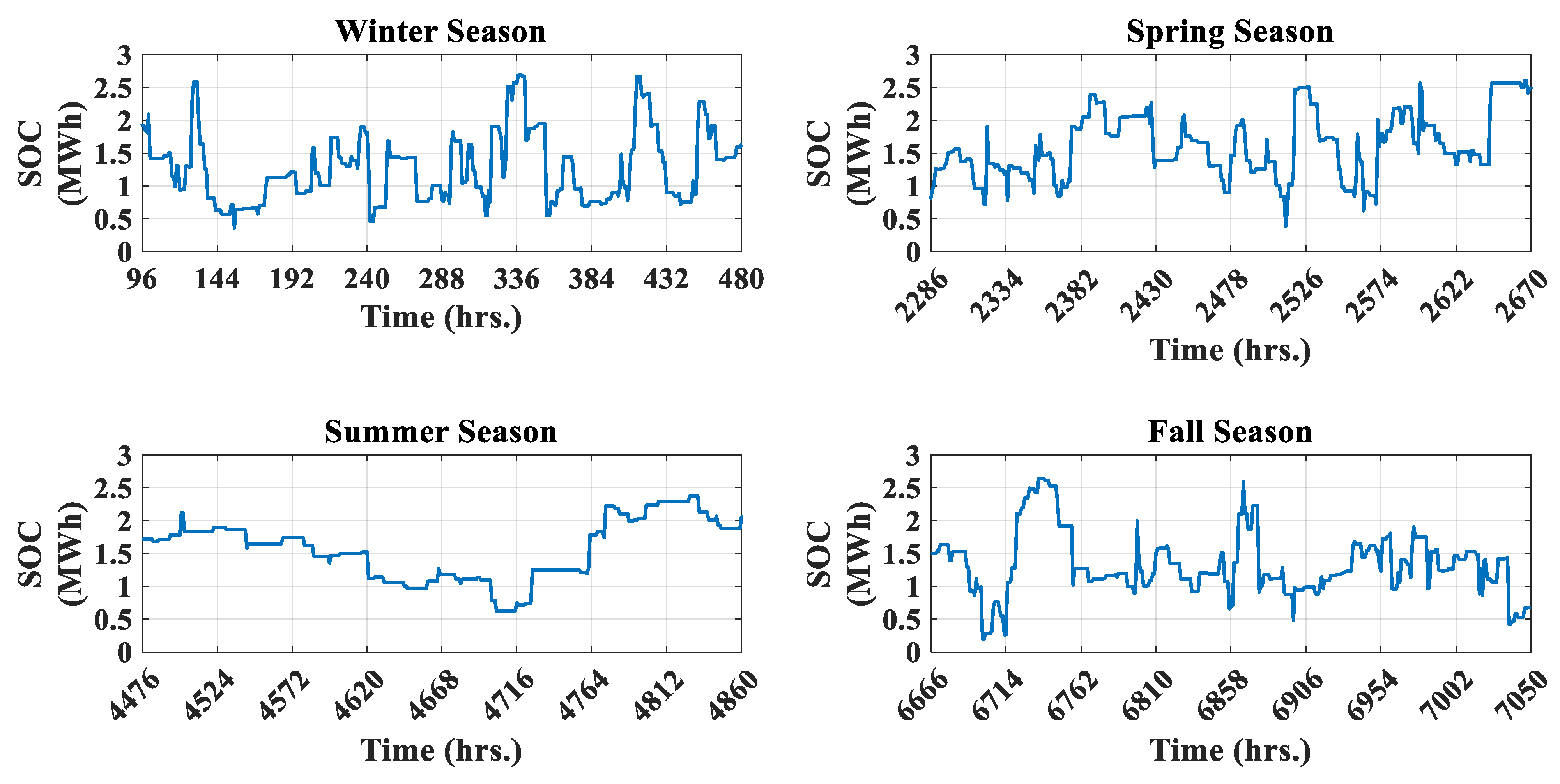
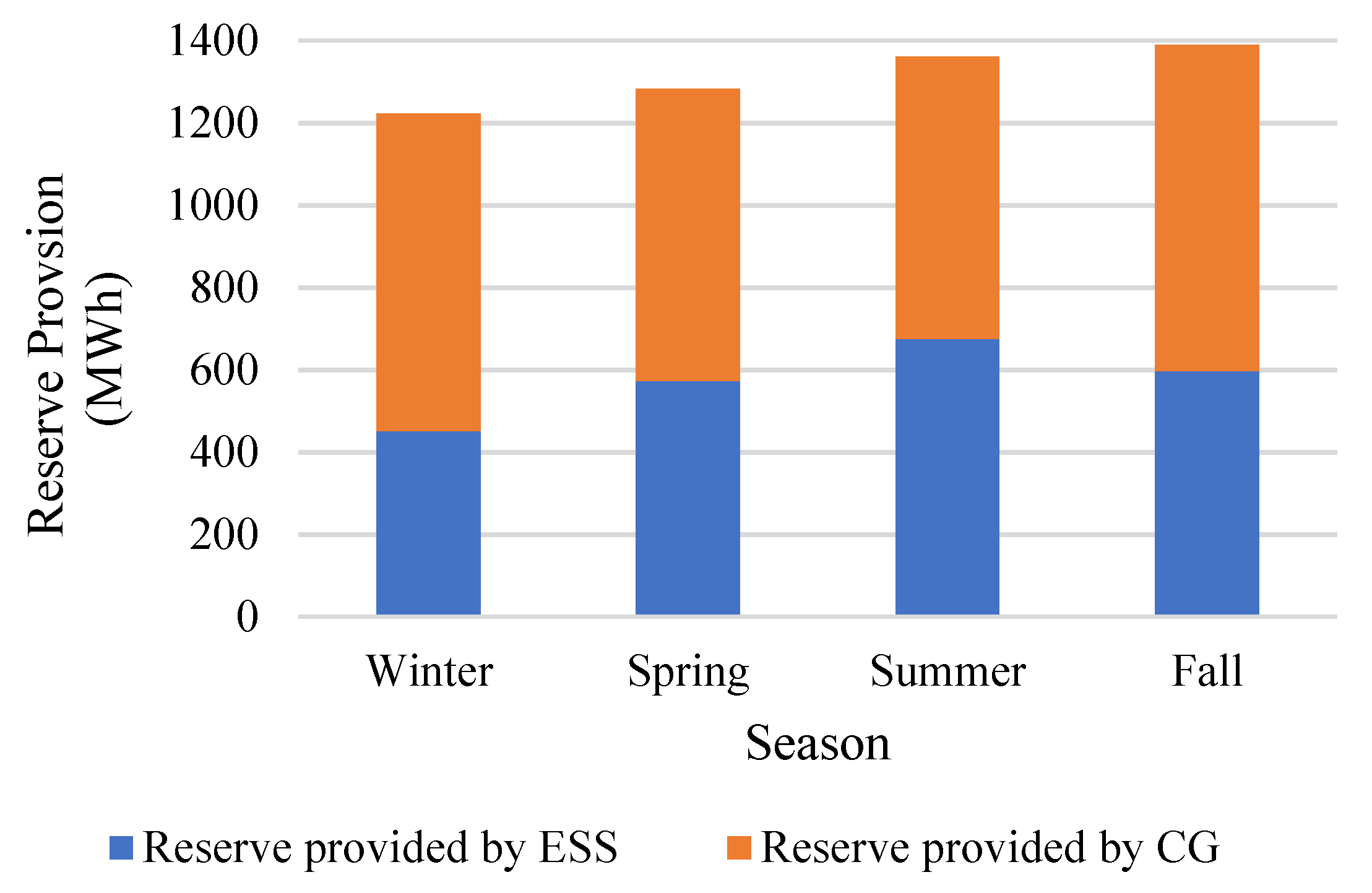
| Parameter/Variable | Description (unit) |
|---|---|
| Parameters and variables for CG units: | |
| CTg | Cold start time (h) |
| DTg/UTg | Minimum down/up times of a CG (h) |
| SUg/SDg | Startup/shutdown limit of a CG (MWh−1) |
| SUcost/SDcost | gth CG linearized startup/shutdown costs |
| sg,t | Binary variable of the gth CG startup status (1: turned on, 0: shut down) |
| rg,t | gth CG reserve provision (MW) |
| RUg/RDg | Ramp-up/down rates of a CG (MW) |
| Maximum/minimum generation limits of a CG (MW) | |
| pg,t is | gth CG produced power (MW) |
| gth CG provided power and reserve (MW) | |
| xg,t | Binary variable of the gth CG status (0: off, 1: on) |
| yg,t | gth CG linearized production cost |
| zg,t | Binary variable of the gth CG shutdown status (1: turned off, 0: otherwise) |
| Parameters and variables for ESS: | |
| αt | Binary variable to prevent ESS’s simultaneous charging and discharging |
| d | ESS energy capacity capital cost ($/MWh) |
| e | ESS power capacity capital cost ($/MW) |
| EESS | Energy capacity of ESS (MWh) |
| Et | ESS energy level or state of charge at time t |
| ηch/ηdis | Charging/discharging efficiency |
| rESS_DN,t | Down reserve provided by the ESS (MW) |
| rESS_UP,t | Up reserve provided by the ESS (MW) |
| R | Reserve requirement (MW) |
| pch,t | Power charging of ESS (MW) |
| pdis,t | Power discharging from ESS (MW) |
| PESS | Maximum discharge/charge rate of ESS (MW) |
| ESS charging power and down reserve (MW) | |
| ESS discharging power and up reserve (MW) | |
| Unit | Cost Coeff. ($/MWh) | Min. Capacity (MW) | Max. Capacity (MW) | Startup Cost ($) |
| 1 | 27.7 | 1 | 5 | 40 |
| 2 | 39.1 | 1 | 5 | 40 |
| Unit | Shutdown Cost ($) | Min. Up Time (h) | Min. Down Time (MW) | Ramp Up/Down Rate (MW/h) |
| 1 | 0 | 3 | 3 | 2.5 |
| 2 | 0 | 3 | 3 | 2.5 |
| Specification | Description |
|---|---|
| pSCG.rated | 0.05 MW |
| NSCG | 50 |
| Gstd | 1000 W/m2 |
| RC | 150 W/m2 |
| qSCG | 0.1667 |
| MTTFSCG | 1500 h. |
| MTTRSCG | 150 h. |
| Specification | Description |
|---|---|
| ESS technology | Li-Ion |
| ηch/ηdis | 85% |
| Energy capital cost | 600k $/MWh |
| Power capital cost | 400k $/MW |
| Lifetime | 20 years |
| Discount rate | 5% |
| e | 51,814 $/MW |
| d | 77,720 $/MWh |
| Demand Type | Average (KWh/Day) | Average (KW) | Peak (KW) | Demand Factor | #Units |
|---|---|---|---|---|---|
| Secondary school | 10,086 | 420.25 | 1212.2 | 0.35 | 1 |
| Primary school | 2656 | 110.67 | 371.78 | 0.3 | 1 |
| Midrise apartment building | 749.81 | 31.24 | 73.64 | 0.42 | 20 |
| Medium office | 2022.5 | 84.27 | 254.42 | 0.33 | 1 |
| Outpatient clinic | 3956.2 | 164.84 | 360.77 | 0.46 | 1 |
| Fast food restaurant | 560.48 | 23.35 | 41.78 | 0.56 | 5 |
| Large office | 17,831 | 742.99 | 1531 | 0.49 | 1 |
| Independent retailer | 923.9 | 38.5 | 104.83 | 0.37 | 5 |
| Case | EESS (MWh) | PESS (MW) | Total Cost ($) | ESS Cost ($) | CG Cost ($) |
|---|---|---|---|---|---|
| CG and PV (no ESS) | NA | NA | 718,638 ± 1042 | NA | 718,638 ± 1042 |
| CG and PV+ESS | 3.0 ± 0.30 | 1.70 ± 0.40 | 815,465 ± 22,259 | 320,514 ± 34,950 | 494,951 ± 20,857 |
Disclaimer/Publisher’s Note: The statements, opinions and data contained in all publications are solely those of the individual author(s) and contributor(s) and not of MDPI and/or the editor(s). MDPI and/or the editor(s) disclaim responsibility for any injury to people or property resulting from any ideas, methods, instructions or products referred to in the content. |
© 2023 by the authors. Licensee MDPI, Basel, Switzerland. This article is an open access article distributed under the terms and conditions of the Creative Commons Attribution (CC BY) license (https://creativecommons.org/licenses/by/4.0/).
Share and Cite
Alamri, A.; AlKassem, A.; Draou, A. Composite Demand-Based Energy Storage Sizing for an Isolated Microgrid System. Sustainability 2023, 15, 1517. https://doi.org/10.3390/su15021517
Alamri A, AlKassem A, Draou A. Composite Demand-Based Energy Storage Sizing for an Isolated Microgrid System. Sustainability. 2023; 15(2):1517. https://doi.org/10.3390/su15021517
Chicago/Turabian StyleAlamri, Abdullah, Abdulrahman AlKassem, and Azeddine Draou. 2023. "Composite Demand-Based Energy Storage Sizing for an Isolated Microgrid System" Sustainability 15, no. 2: 1517. https://doi.org/10.3390/su15021517






